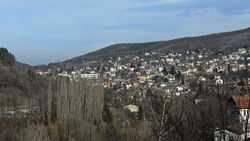Vladaya
| Vladaya Владая | |
|---|---|
| Village | |
 | |
 Vladaya | |
| Coordinates: 42°38′N 23°12′E / 42.633°N 23.200°ECoordinates: 42°38′N 23°12′E / 42.633°N 23.200°E | |
| Country |
|
| Province (Oblast) | Sofia-Capital |
| Named as "Vladaya" | 13th century |
| Government | |
| • Mayor | Vasko Stoyanov (I) |
| Elevation | 850 m (2,790 ft) |
| Population (Census 2011)[1] | |
| • Total | 4,040 |
| Time zone | EET (UTC+2) |
| Postal Code | 1641 |
| Area code(s) | (+359) 02 999 |
| Car plates | C, CA |
| Website | www.vladaya.net |
Vladaya (Bulgarian: Владая, pronounced [vɫɐdajɐ]) is a village situated on the Vitosha and Lyulin mountains in western Bulgaria at an altitude of about 1000 m. In the 2011 census in Vladaya were counted 4040 residents, which makes it the 10th-largest village in Bulgaria.[1]
.jpg)
Geography and population
The village is landlocked from valleys, situated comparatively highly in the mountains where Vitosha and Lyulin Mountain meet at the Vladaya River. However only a small neoghborhood falls within Lyulin and the village is mostly situated on the northwestern parts of Vitosha. The population consists mainly of Bulgarians. There is a small gypsy minority living in the village.
History
The history of the village reflects the fate of the near-by Sofia city. It is believed that there has been a settlement on the site since ancient eras. The first known inhabitants of the area were Thracian tribes. The settlement was part of numerous kingdoms and empires - Thracian and Macedon kingdoms, Roman, Byzantine, Bulgarian and Ottoman empires. Over the centuries, different tribes and peoples invaded the area - Macedonians, Celts, Romans, Goths, Bulgarians, Turks, Russians and others. There is one legend and two alternative theories about the name of the village. According to the first legend, the village's name dates back the Second Bulgarian Empire(1185 - 1396) and was named after one of the three daughters of the tsar called Vladaya. Her sisters' names - Boyana and Yana gave name to other settlements in the area. The alternative theory is that the name is derived from the Bulgarian word "владей" [vladey] which literary means own in imperative, the other alternative theory is that it is simply derived from villa. Etymological studies derive it from the genitive and accusative form of the Bulgarian personal name Vladay.[2] The name of Vladaya was first attested in 1576 as Viladay or Vladay.
Landmarks
- Tourist track Zlatnite Mostove"
- Tourist track "Tihia kat"
- Sveta Petka monastery
- Sveti Ivan Rilski monument
- Monument of the soldiers killed in the soldier rebellion in 1918
- Monument of Lessya Ukrainka - a Ukrainian poetess
Honour
Vladaya Saddle on Livingston Island in the South Shetland Islands, Antarctica is named after Vladaya.
References
- ↑ 1.0 1.1 "Смаляваща се България - за 10 години с 600 000 души" (in Bulgarian). Dnevnik. Remark: you should be registered in dnevnik.bg to read the whole article, but you can read the whole article without registration through entering dnevnik.bg's article in page 2 of these results in Google
- ↑ Чолева-Димитрова, Анна М. (2002). Селищни имена от Югозападна България: Изследване. Речник (in Bulgarian). София: Пенсофт. p. 107. ISBN 954-642-168-5. OCLC 57603720.
External links
| Wikimedia Commons has media related to Vladaya. |
- Position on bgmaps.com
- Position on emaps.bg
- Position on Google Maps
- Web Portal of Sofia municipality
- Watershed of Vladaya river